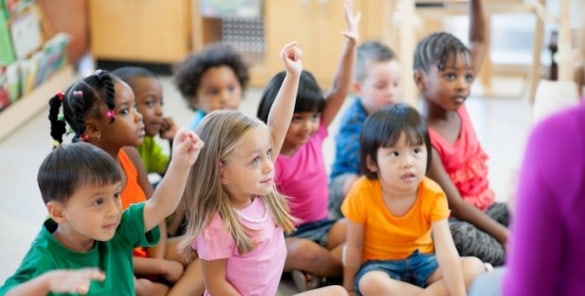When children turn four years old, some states will have pre-kindergarten or preschool classes. The US education system invests in early childhood education as kids who attend preschool programs are often better prepared for kindergarten. While preschool is important, not all programs are alike. Preschool programs should be well implemented, use an evidence-based curriculum and place an emphasis on the quality and continuous training of pre-school teachers.
Preschool is more than learning the ABCs.
There are both social and academic benefits to a good preschool program. Children learn about group behaviors – what is acceptable and what is not. They experience a modified classroom environment and learn about school schedules – reading circle, snack time, outdoor play, naps, etc. This allows them to better adapt to kindergarten.
In preschool, children learn about the world through play.
Academic subject areas aren’t separated in their minds or in the classroom. The objects preschoolers find on a nature walk, like feathers, rocks and leaves, might help them figure out math concepts like “big, bigger, and biggest” or motivate them to visit the book corner to find out more about birds. Teachers may introduce children to basic concepts such as shapes, letters, and colors, but preschool is about learning much more than what a circle looks like. It’s about exploring, having fun and how children develop their relationship with learning.
Preschool is all about discovery.
Preschool teachers should have a curriculum that includes academic, social, physical and emotional lessons. For literacy, preschoolers will hear stories read aloud, spend time talking with classmates, and learn to put their thoughts and feelings into words. Writing is mostly scribbling but shapes that resemble letters begin to emerge and children will learn to write their names. Some programs will start teaching sight words.
To implement the curriculum, preschool teachers can focus on language and math while incorporating science, and social studies. Numbers will be used to count as well as differentiate shapes, often using art. Patterns will also be taught. Preschoolers love to explore so teaching science revolves around observing and experimenting as they read about animals and play with rocks, leaves, and grow grass. Children will test what sinks and floats in the water table. Social studies can be introduced through learning about their role in the world, conflict resolution, taking turns, and helping to clean up.
Play is fun but it’s also how children learn to interact with each other. While in preschool, children will form friendships, learn to take turns and learn how to cooperate. While at the sand box or water table, children can try different problem-solving techniques and use their imagination. While thinking creatively, they can also partner to do an activity and talk to each other about their ideas.
Preschool curricula and activities depend on the length of the preschool day. Many preschools run for only a few hours a day, while others (especially in public school settings) run for much longer days. Some even run longer than a typical school day to cover all the parent’s work hours.
Nannies can learn more about caring for preschoolers by enrolling in the Intermediate Childcare certification program at the Nanny Institute.


Recent Comments